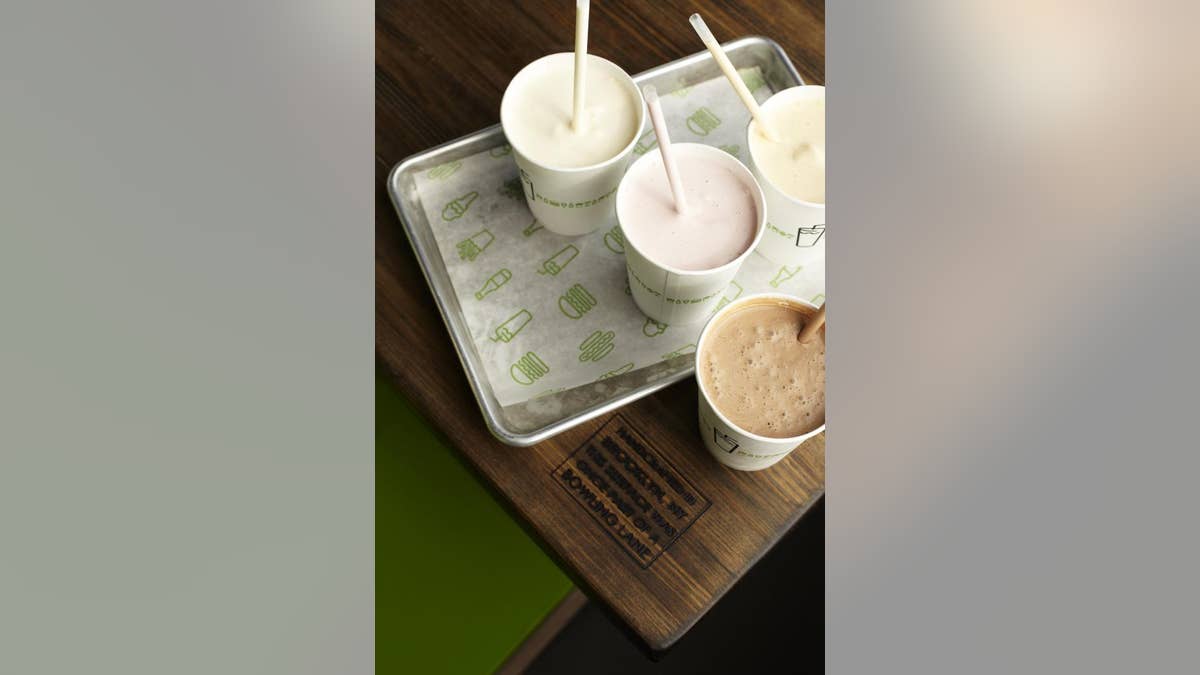
(William Brinson)
If you've ever been to Shake Shack, you probably know why the line frequently stretches out the door and down the block.
People don't seem to mind the wait, either. Food is made to order at Shake Shack, and that's just fine with the customers. Plus, they can use their time to scan the oversized menus for new items, like a quirky new custard flavor or a brand-new burger, and maybe find something new that tantalizes their taste buds.
At least that's what Mark Rosati — Shake Shack's culinary development manager — is hoping.
"I wear a couple of different hats at Shake Shack," says Rosati over the phone from London. "I head up the culinary team, create new menu items, tweak old menu items. I help with how we'll develop down the road."
Rosati is currently on a weeks-long world tour, getting the lay of the land(s) before the restaurant's newest locations open overseas. "We're gonna open in Istanbul and the U.K., hopefully this summer," says Rosati.
That's a remarkable leap for an eatery that began as a single mobile cart in New York City. Since 2004, however, Shake Shack has steadily expanded its operations to include more than a dozen permanent burger joints in cities along the east coast, not to mention its several outposts in the Middle East and concession stands at major sports arenas. And there's plenty more planned, both home and abroad, because people just can't get enough of those burgers, shakes and fries.
Rosati is also one of those people.
"I can’t tell you how many times I’ve eaten burgers in other cities," says Rosati. "But there's something about [a Shake Shack burger] that I love."
In London alone, he's already sampled several "excellent" offerings. "Their burger culture is serious. It makes New York blush," says Rosati. "The bar is already so high; I hope we fit in here."
But Rosati is doing all in his power to make sure Shake Shack "fits in" with the new crowd. Part of his job is to meet with London's notable chefs, butchers and bakers to find out what makes the city's culinary landscape so special. Then, he begins to fine-tune Shake Shack's menu accordingly — but it's never about stealing. "I like to pay homage to what they do, and treat it with the respect it deserves," says Rosati.
In fact, Rosati pays more than homage to the town's local favorite dishes; in most cases, he develops specific menu items alongside local chefs, many of which utilize their products or services. The Shake Shacks in Florida, for example, serve up a special "concrete" (Shake Shack's signature frozen dessert consisting of custards and mix-ins) blended with a slice of key lime tart from Palm Beach's famous Sugar Monkey bakery, and the location in Philadelphia uses crushed cannoli shells from the Termini Brothers pastry shop, a Philly hometown favorite. ("They make the best cannoli I've ever had in my entire life," says Rosati.)
Sometimes, he adds, these local recipes grow so popular, that they become fixture items at all of the Shake Shacks. The Handsome Dog from the location in New Haven, Conn. (named in honor of Yale University's bulldog mascot, Handsome Dan) was such a hit, it's now featured on all other Shake Shack menus as the Dapper Dog. And while the Mast Brothers of Brooklyn, N.Y., have always provided the chocolate blends, they're now the makers of Shake Shack's signature dark chocolate bar.
But Rosati doesn't always look to the locals for his inspiration. Admittedly, he creates some items as "an attempt to harness [his] childhood." Many of these ideas often wind up on Shake Shack's rotating custard menu, such as the Oatmeal Cream Pie custard, which Rosati describes as "a loving tribute to Little Debbie."
“I like to push the envelope," says Rosati, "but when I get too crazy, my team keeps me in check."
Translating his ideas into edibles is sometimes harder than it sounds, though. Some items, like the new-ish SmokeShack burger (with applewood-smoked bacon and chopped pickled cherry peppers), came together fairly quickly, but others were the result of trial-and-error processes, and when perfected, they're brought before the company's CEO as well as Danny Meyer, the restaurateur behind Shake Shack. Still, some items never even make it to the menu.
"We get lots of input to make sure it fits the mold of Shake Shack," says Rosati.
In other words, Rosati knows where Shake Shack's bread is buttered (and toasted). "What we do best is the burgers, the fries and the shakes," he acknowledges. "It really goes back to the ingredients you’re using, and … the quality of the meat. In the end, all we’re putting on that [beef] is salt and pepper, and if you order a burger [with no sauces or toppings], I can still guarantee you’ll be handsomely rewarded."
That being said, if Rosati can give Shake Shack's customers something a bit more unique to try, he will. And if its in a fun environment, all the better.
“I think it’s always funny, and I think about this a lot: We put so much thought into the food, but it’s all about the essence of the community, which is what the classic burger stand was in the '50s. It’s just about people coming together under one roof and having a great time."
And that, Rosati seems to understand, is a concept that will work just as well in New York City as it will in Istanbul or London.
